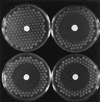Hypersensitivity of Escherichia coli Delta(uvrB-bio) mutants to 6-hydroxylaminopurine and other base analogs is due to a defect in molybdenum cofactor biosynthesis
- PMID: 10852865
- PMCID: PMC101891
- DOI: 10.1128/JB.182.12.3361-3367.2000
Hypersensitivity of Escherichia coli Delta(uvrB-bio) mutants to 6-hydroxylaminopurine and other base analogs is due to a defect in molybdenum cofactor biosynthesis
Abstract
We have shown previously that Escherichia coli and Salmonella enterica serovar Typhimurium strains carrying a deletion of the uvrB-bio region are hypersensitive to the mutagenic and toxic action of 6-hydroxylaminopurine (HAP) and related base analogs. This sensitivity is not due to the uvrB excision repair defect associated with this deletion because a uvrB point mutation or a uvrA deficiency does not cause hypersensitivity. In the present work, we have investigated which gene(s) within the deleted region may be responsible for this effect. Using independent approaches, we isolated both a point mutation and a transposon insertion in the moeA gene, which is located in the region covered by the deletion, that conferred HAP sensitivity equal to that conferred by the uvrB-bio deletion. The moeAB operon provides one of a large number of genes responsible for biosynthesis of the molybdenum cofactor. Defects in other genes in the same pathway, such as moa or mod, also lead to the same HAP-hypersensitive phenotype. We propose that the molybdenum cofactor is required as a cofactor for an as yet unidentified enzyme (or enzymes) that acts to inactivate HAP and other related compounds.
Figures



Similar articles
-
TusA (YhhP) and IscS are required for molybdenum cofactor-dependent base-analog detoxification.Microbiologyopen. 2013 Oct;2(5):743-55. doi: 10.1002/mbo3.108. Epub 2013 Jul 29. Microbiologyopen. 2013. PMID: 23894086 Free PMC article.
-
Molybdenum cofactor-dependent resistance to N-hydroxylated base analogs in Escherichia coli is independent of MobA function.Mutat Res. 2007 Jun 1;619(1-2):9-15. doi: 10.1016/j.mrfmmm.2006.12.005. Epub 2007 Feb 2. Mutat Res. 2007. PMID: 17349664 Free PMC article.
-
Genetic characterization of moaB mutants of Escherichia coli.Res Microbiol. 2013 Sep;164(7):689-94. doi: 10.1016/j.resmic.2013.05.001. Epub 2013 May 13. Res Microbiol. 2013. PMID: 23680484 Free PMC article.
-
Biosynthesis and processing of the molybdenum cofactors.Biochem Soc Trans. 1997 Aug;25(3):757-61. doi: 10.1042/bst0250757. Biochem Soc Trans. 1997. PMID: 9388540 Review. No abstract available.
-
Biogenesis of molybdenum cofactors.Crit Rev Microbiol. 1990;17(3):169-88. doi: 10.3109/10408419009105724. Crit Rev Microbiol. 1990. PMID: 2405878 Review. No abstract available.
Cited by
-
Pivotal role of inosine triphosphate pyrophosphatase in maintaining genome stability and the prevention of apoptosis in human cells.PLoS One. 2012;7(2):e32313. doi: 10.1371/journal.pone.0032313. Epub 2012 Feb 27. PLoS One. 2012. PMID: 22384212 Free PMC article.
-
Role for CysJ flavin reductase in molybdenum cofactor-dependent resistance of Escherichia coli to 6-N-hydroxylaminopurine.J Bacteriol. 2010 Apr;192(8):2026-33. doi: 10.1128/JB.01438-09. Epub 2010 Jan 29. J Bacteriol. 2010. PMID: 20118259 Free PMC article.
-
Genome-wide screening for genes whose deletions confer sensitivity to mutagenic purine base analogs in yeast.BMC Genet. 2005 Jun 2;6:31. doi: 10.1186/1471-2156-6-31. BMC Genet. 2005. PMID: 15932646 Free PMC article.
-
Quantitative in vitro and in vivo characterization of the human P32T mutant ITPase.Biochim Biophys Acta. 2010 Feb;1802(2):269-74. doi: 10.1016/j.bbadis.2009.11.002. Epub 2009 Nov 13. Biochim Biophys Acta. 2010. PMID: 19914375 Free PMC article.
-
The three faces of riboviral spontaneous mutation: spectrum, mode of genome replication, and mutation rate.PLoS Genet. 2012;8(7):e1002832. doi: 10.1371/journal.pgen.1002832. Epub 2012 Jul 26. PLoS Genet. 2012. PMID: 22844250 Free PMC article.
References
-
- Bessman M J, Frick D N, O'Handley S F. The MutT proteins or “nudix” hydrolases, a family of versatile, widely distributed, “housecleaning” enzymes. J Biol Chem. 1996;271:25059–25062. - PubMed
-
- Budowski E I. The mechanisms of the mutagenic action of hydroxylamine. Prog Nucleic Acid Res Mol Biol. 1976;16:125–182. - PubMed
Publication types
MeSH terms
Substances
LinkOut - more resources
Full Text Sources
Molecular Biology Databases

